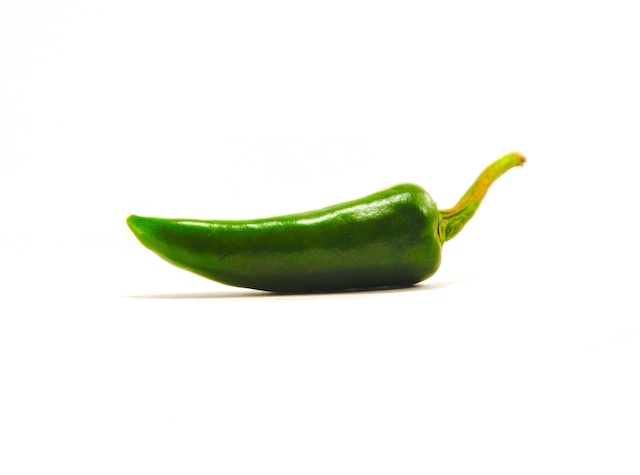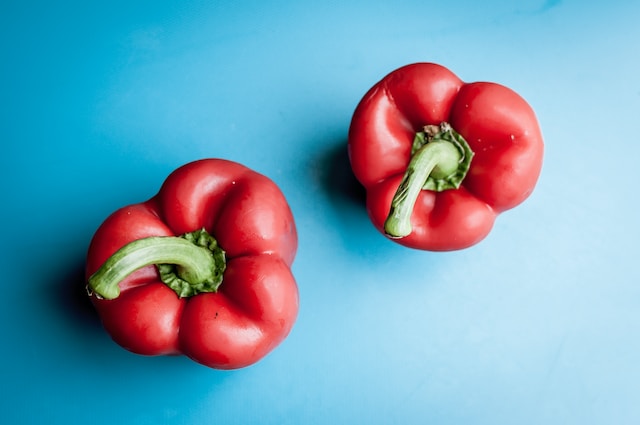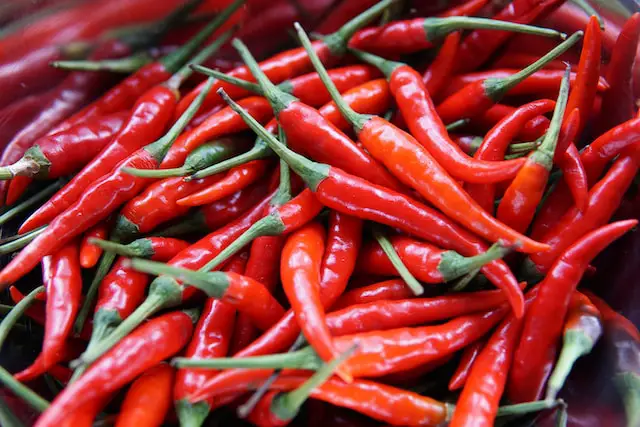Chilli refers to the fruit of plants belonging to the Capsicum genus and is known for its fiery heat. Pepper refers specifically to black, white, green, or red peppercorns derived from the Piper nigrum plant.
TL;DR Chilli Vs. Pepper
Chilli and pepper are two different types of spices. Chilli comes from the Capsicum genus and has a wide range of heat levels, while pepper comes from the Piper genus and is generally milder.
Chilli is used for spiciness and flavor in dishes, while pepper is used for seasoning.
What is Chilli?

Chilli refers to the fruit of plants from the Capsicum genus. These fruits are typically small and come in various shapes and colors, ranging from vibrant reds to mellow yellows.
Chillies are known for their intense heat and pungent flavor that can leave your taste buds tingling with excitement. This fiery sensation is primarily attributed to a compound called capsaicin found in the flesh and seeds of the fruit.
Chillies also boast an array of health benefits. They contain high levels of vitamins A and C, as well as antioxidants that help boost immunity and fight inflammation.
What is Pepper?

Pepper, also known as black pepper or Piper nigrum, is a popular spice that adds flavor and heat to dishes. It comes from the berries of the pepper plant, which are dried and ground into a powder. Pepper has been used for centuries in cooking and medicine due to its distinctive taste and potential health benefits.
Chilli history
The use of chilli peppers can be traced as far back as 7500 BC in Mexico. Archaeologists have discovered evidence of chilli cultivation in ancient Mayan and Aztec ruins, suggesting that these civilizations held the plant in high regard.
Chilli peppers were highly valued by these early cultures not only for their spicy flavor but also for their perceived health benefits. They believed that consuming chillies could help relieve pain, boost immunity, improve digestion, and even act as an aphrodisiac.
During the age of exploration, European explorers like Christopher Columbus encountered chilli peppers during their voyages to the New World. These explorers brought chillies back to Europe, where they quickly gained popularity among traders and chefs alike.
Pepper History
Pepper is believed to have originated in the Western Ghats of India and has been used for thousands of years both as a spice and for medicinal purposes.
The ancient Egyptians were among the first to use pepper, with evidence of its use dating back to at least 2000 BC. Pepper quickly became highly prized and sought after by ancient civilizations such as the Greeks and Romans.
In fact, it was so valuable that it was often used as currency and even considered a sacred offering.
During the Middle Ages, pepper played a significant role in global trade. European explorers like Christopher Columbus set out on voyages in search of new trade routes to obtain this precious spice directly from its source in India.
Pepper’s popularity continued through the centuries, leading to the establishment of lucrative spice trade routes between Europe and Asia.
These trade routes not only introduced spices like pepper but also had a profound impact on world history by connecting different cultures and fueling exploration.
Chilli Vs. Pepper – Key differences
| Feature | Chilli | Pepper |
|---|---|---|
| Botanical Family | Capsicum genus (Solanaceae family) | Piper genus (Piperaceae family) |
| Origin | Native to the Americas (Mexico and beyond) | Native to South Asia and Southeast Asia |
| Heat Level | Can range from mild to extremely hot | Generally mild (black and white pepper), but can have hotter varieties (like cayenne pepper) |
| Flavor Profile | Often fruity and pungent | Mild, slightly spicy, and aromatic |
| Culinary Use | Commonly used in spicy dishes and salsas | Used to add flavor and seasoning to various dishes |
| Capsaicin Content | Contains capsaicin, responsible for the heat | Does not contain capsaicin |
| Varieties | Many different varieties and colors | Black, white, green, and red varieties available |
| Growing Conditions | Prefer warm climates and well-drained soil | Prefer tropical or subtropical climates |
| Health Benefits | Rich in vitamins, antioxidants, and minerals | Contains antioxidants and may aid digestion |
| Examples | Jalapeño, Habanero, Thai Chilli, etc. | Black Pepper, White Pepper, Green Pepper, etc. |
The different types of chillis and peppers
Types of Chillies
- Jalapeño (Capsicum annuum): A medium-sized, green or red chilli with a moderate heat level. It’s commonly used in Mexican cuisine, salsas, and as a topping for various dishes.
- Habanero (Capsicum chinense): A small, lantern-shaped chilli known for its intense heat and fruity flavor. It’s often used in hot sauces and Caribbean dishes.
- Thai Chilli (Capsicum annuum): Small, slender chillies with a high heat level. They are commonly used in Thai and Southeast Asian cooking.
- Cayenne Pepper (Capsicum annuum): A long, thin red chilli with a significant heat level. It’s often used in powdered form to add spiciness to dishes.
- Serrano (Capsicum annuum): Similar to jalapeño but smaller and hotter. It’s commonly used in salsas, pico de gallo, and Mexican cuisine.
- Poblano (Capsicum annuum): A mild, large, heart-shaped chilli often used for stuffing in dishes like chile rellenos.
- Anaheim (Capsicum annuum): A mild to medium heat chilli commonly used in Southwestern and Mexican dishes.
Types of Peppers (Peppercorns)
- Black Pepper (Piper nigrum): The most common and widely used type of pepper. It has a mildly spicy and pungent flavor.
- White Pepper (Piper nigrum): Made from fully ripe pepper berries with the outer skin removed, resulting in a milder flavor compared to black pepper.
- Green Pepper (Piper nigrum): Immature pepper berries that are picked before ripening. They have a fresh, mild taste.
- Pink/Red Pepper (Schinus terebinthifolius): Not true peppercorns but berries from the Brazilian Pepper tree. They have a sweet and slightly spicy flavor.
- Sichuan Pepper (Zanthoxylum genus): Also known as Chinese pepper, it is not a true pepper but provides a unique tingling and numbing sensation in Sichuan cuisine.
- Long Pepper (Piper longum): An ancient type of pepper with a complex flavor, used in traditional Asian and Indian cooking.
Image Credits
Featured Image By – Elle Hughes on Unsplash
Image 1 By – Hari Krishnan on Unsplash









